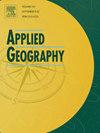Ripples of blue: Unveiling the influence of urban blue spaces on public happiness through social networking sites
IF 4
2区 地球科学
Q1 GEOGRAPHY
引用次数: 0
Abstract
The high density and rapid pace characteristic of urban environments pose significant challenges to human health. While an expanding corpus of research underscores the mitigating effects of natural environments on these adverse impacts, the empirical evidence pertaining to the benefits of urban blue spaces remains relatively sparse, particularly in terms of their potential to bolster happiness. This study innovatively applied a BERT-based sentiment analysis model to geotagged social media data, offering a novel approach to quantify public happiness expressions in urban blue spaces. We utilize three happiness indices—Happiness Probability Index (HPI), Happiness Intensity Index (HII), and Happiness Evenness Index (HEI)—to explore the spatial effects of blue spaces on well-being. The results indicate that different types of blue spaces exert distinct influences on happiness, with urban rivers showing a stronger effect on happiness probability and evenness compared to lakes, ponds, and artificial water features. Regression analysis further reveals that proximity to blue spaces significantly enhances happiness within both 400m and 800m buffer zones, and that spatial organization and morphological characteristics are closely linked to happiness intensity. These findings provide evidence-based recommendations for designing and planning urban blue spaces to optimize their benefits for public health.

蓝色涟漪通过社交网站揭示城市蓝色空间对公众幸福感的影响
城市环境所特有的高密度和快节奏给人类健康带来了巨大挑战。尽管越来越多的研究强调了自然环境对这些不利影响的缓解作用,但有关城市蓝色空间益处的实证证据仍然相对稀少,尤其是在其提高幸福感的潜力方面。本研究创新性地将基于 BERT 的情感分析模型应用于地理标记的社交媒体数据,提供了一种量化城市蓝色空间中公众幸福表达的新方法。我们利用三种幸福指数--幸福概率指数(HPI)、幸福强度指数(HII)和幸福均匀度指数(HEI)--来探讨蓝色空间对幸福感的空间影响。结果表明,不同类型的蓝色空间对幸福感的影响各不相同,与湖泊、池塘和人工水景相比,城市河流对幸福概率和均匀度的影响更大。回归分析进一步揭示,在 400 米和 800 米缓冲区内,靠近蓝色空间可显著提高幸福感,空间组织和形态特征与幸福感强度密切相关。这些发现为城市蓝色空间的设计和规划提供了循证建议,以优化其对公众健康的益处。
本文章由计算机程序翻译,如有差异,请以英文原文为准。
求助全文
约1分钟内获得全文
求助全文
来源期刊

Applied Geography
GEOGRAPHY-
CiteScore
8.00
自引率
2.00%
发文量
134
期刊介绍:
Applied Geography is a journal devoted to the publication of research which utilizes geographic approaches (human, physical, nature-society and GIScience) to resolve human problems that have a spatial dimension. These problems may be related to the assessment, management and allocation of the world physical and/or human resources. The underlying rationale of the journal is that only through a clear understanding of the relevant societal, physical, and coupled natural-humans systems can we resolve such problems. Papers are invited on any theme involving the application of geographical theory and methodology in the resolution of human problems.
 求助内容:
求助内容: 应助结果提醒方式:
应助结果提醒方式:


